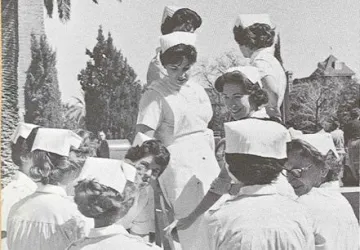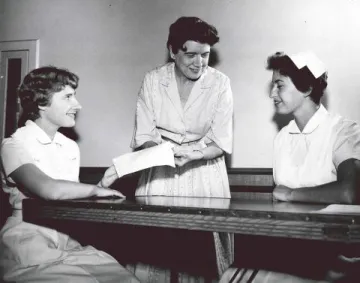
The University of Arizona College of Nursing was established in 1957.
Formal nursing education came to Arizona when St. Joseph's Hospital in Formal nursing education came to Arizona when St. Joseph's Hospital in Phoenix established a three-year diploma program. By 1944, five Arizona hospitals had such programs. In 1950, the U.S. Public Health Service survey revealed a nursing shortage in Arizona and a need for nursing education in the state. During the 1950s, two organizations helped arrange and consolidate regional education in nursing: the Western Conference for Higher Education in Nursing (WCHEN); and the Western Interstate Commission for Higher Education (WICHE). The latter was a clearinghouse for regional programs in medicine, dentistry, veterinary medicine and nursing.
Arizona's governor and university presidents began discussing the need for a baccalaureate nursing program in the early 1950s. At about the same time, Pearl Parvin Coulter began traveling regularly from the University of Colorado, where she was on the faculty, to Good Samaritan Hospital in Phoenix to teach public-health nursing.
By 1955, Arizona was the only U.S. state without a baccalaureate nursing program. Available clinical settings were "primitive" according to Pearl Coulter. Tucson Medical Center had termites in the beams of its pediatric unit and had reported at least one instance of a bull snake slithering into a patient room.

The original nursing cap–suggestive of a mantilla, mountains, and a saguaro cactus–designed by George Harvill, the wife of then UA president Richard Harvill.
Founding the School of Nursing
The original nursing cap–suggestive of a mantilla, mountains, and a saguaro cactus–designed by George Harvill, the wife of then UA president Richard Harvill.Pearl Coulter was named professor and director of the new School of Nursing in the College of Liberal Arts at the University of Arizona in 1957. She came to the UA with 20 years of experience teaching public health in an academic setting and had been head of the Public Health Nursing Section of the University of Colorado School of Nursing.
The School's first home was a conference room in the Liberal Arts Building. Expansion was meager but rapid, beginning with a lab in the new Biological Sciences Building. Professor Coulter (like Dean Gladys Sorensen who succeeded her) managed development single-handed, beginning with a $1,000 gift from Phoebe Pack for a director's discretionary fund. An informally organized group of men, dubbed HABBJACH (for the initials of their first names), started a UA scholarship program in the early 1960s, with about a third of these "Dollars for Scholars" going to the College of Nursing.
There were 42 students in the first class, and the school's budget for the year was about $23,000. Tucson Medical Center provided the first clinical setting.The original nursing students' uniform was a pink-and-white pinafore with a cap and pin. The cap–suggestive of a mantilla, mountains, and a saguaro cactus–was designed by George Harvill, the wife of then UA president Richard Harvill.
Embracing the Community
Professor Coulter guided the College of Nursing toward the principles it follows to this day. She emphasized the science and art of nursing, the continuity of patient care within the family, clinical nursing research, cross-cultural perspectives and community outreach. Nurses, she believed, should have a patient-focused learning experience, caring for patients "wherever they happened to be." Students must be trained as practitioners, but also for academic, administrative and research careers.
Professor Coulter worked to recruit international and minority students. The first two students from Mexico enrolled in the program in 1961.
The School sponsored WCHEN continuing-education courses on nursing leadership and hosted a conference on child development and family life during its very first summer session. Through the 1960s, continuing-education conferences were offered on tuberculosis nursing, cultural and ethnic factors in nursing, work satisfaction in nursing, school nursing, nursing-home administration and many other topics.
Collaborating with the School of Home Economics, the School of Nursing offered a cross-cultural health seminar series with healers from Native American and Mexican traditions.
Growth and Development
The School quickly outgrew its original quarters and relocated to the basement of the new Home Economics Building in 1959. In the ensuing years, the School spread to quarters in the UA stadium building and in a former real-estate office near campus.
By 1963, there were 200 students in the program. The School had developed agreements with 10 Tucson health-care facilities, including hospitals, the county health department and the Tucson Visiting Nurses' Association, to form a core of labs for the program's rapidly expanding student population.
The College published research entitled "Cultural Components in Public Health Nursing," which studied health beliefs and practices of residents of the San Xavier Reservation. Out of this research came the guidebook, Cultural Components: A Manual for Nurses.
The seeds were being sown for a Doctor of Philosophy (PhD) in Nursing through this and other research emphasizing clinical nursing research and theory development. Meanwhile, a Master of Science degree with a nursing major won approval in 1967 - the same year the UA College of Medicine in Tucson opened.
Having seen her vision of patient-centered education, scholarship and research well on its way to realization, Professor Coulter retired in 1967, and Dr. Gladys Sorensen succeeded her as dean. That same year, construction began on the new College of Nursing building.
Research and Outreach
In the early 1970s, UA nursing faculty traveled to distant communities to teach nurses throughout the state. As a forerunner to other graduate programs, the College began offering a nurse-specialist degree in subspecialties such as pulmonary, oncology and primary-care nursing. Nurse practitioner preparation began with the Family Nurse Practitioner Program at Tucson's El Rio Neighborhood Health Center. The program would expand to include obstetrics-gynecology, geriatric and neonatal nurse practitioners. In 1972, the College established the Katie Ugo Health Center at Tucson's Armory Park Senior Center.
Research in nursing phenomena was coming into its own during the 1970s. The College of Nursing organized a 1973 nursing research conference, which has grown from a local gathering to an international symposium. It was one of the first such conferences in the U.S.
Clinical-practice settings were growing more diverse, reflecting Pearl Coulter's belief that nursing students should have behavioral and biological science courses at the same level as majors in those fields. The College organized its PhD program in the mid-1970s, graduating 17 doctoral students during the first decade.
During the 1980s, the College established the Nurse-Midwifery Education Program and an interdisciplinary rural-health nursing program. The latter placed graduate students in Cochise County towns–Willcox, Benson and Douglas–for 10-week fellowships including patient teaching, nursing care, blood-pressure screening and teen prenatal counseling. Participants were graduate students in community health nursing, social work, pharmacy, medicine and health-care administration.
Expansion and Distinction
The Alumni Council was founded in 1982. The purposes of the Council included honoring remarkable faculty and students, holding a continuing-education conference, raising money for scholarships and sponsoring licensure exam review.
After 20 years dedicated to guiding the College of Nursing through exponential growth, impressive development and international prestige, Dean Sorensen retired and L. Claire Parsons became dean in 1987. Coming to the UA with a strong research background in physiology, Dean Parsons brought major progress to the research and scholarship missions during her tenure.
The College of Nursing Advisory Board first met in 1987. Its mission was to represent the College's goals to the community, advise the College on key issues, seek long-term support and encourage relationships within Arizona. The same year, the College of Nursing ranked seventh in the influential ranking published annually by U.S. News and World Report. In a 1993 survey of nurse researchers and nursing college deans, the UA College of Nursing ranked sixth among 491 nursing programs.
Professor Suzanne Van Ort became the College's dean in 1992, having graduated in the second UA College of Nursing class with a Bachelor of Science in Nursing (BSN) in 1962. She had been dean at the University of Wisconsin-Eau Claire and had served in the U.S. Navy Nurse Corps.
As technology became more available and affordable, the UA College of Nursing, along with nursing programs at Northern Arizona and Arizona State universities, began offering teleconference courses to students in remote locations. Additional technological advances allowed for developing the online doctoral program and the accelerated program.
Marjorie A. Isenberg became dean in 2001. She was associate dean of the Wayne State University College of Nursing for seven years and has been a visiting professor at universities in the Netherlands and Mexico. While Dr. Isenberg was at the UA College of Nursing, exciting new programs were launched including an accelerated baccalaureate nursing degree program for college graduates and an online doctoral program through which students could complete most of their PhD studies without coming to the UA campus.
The Best Is Yet to Come
As the College of Nursing continues to grow and change, the vision of its first dean, Pearl Parvin Coulter, continues to be enacted in patient-centered education, research and scholarship.

